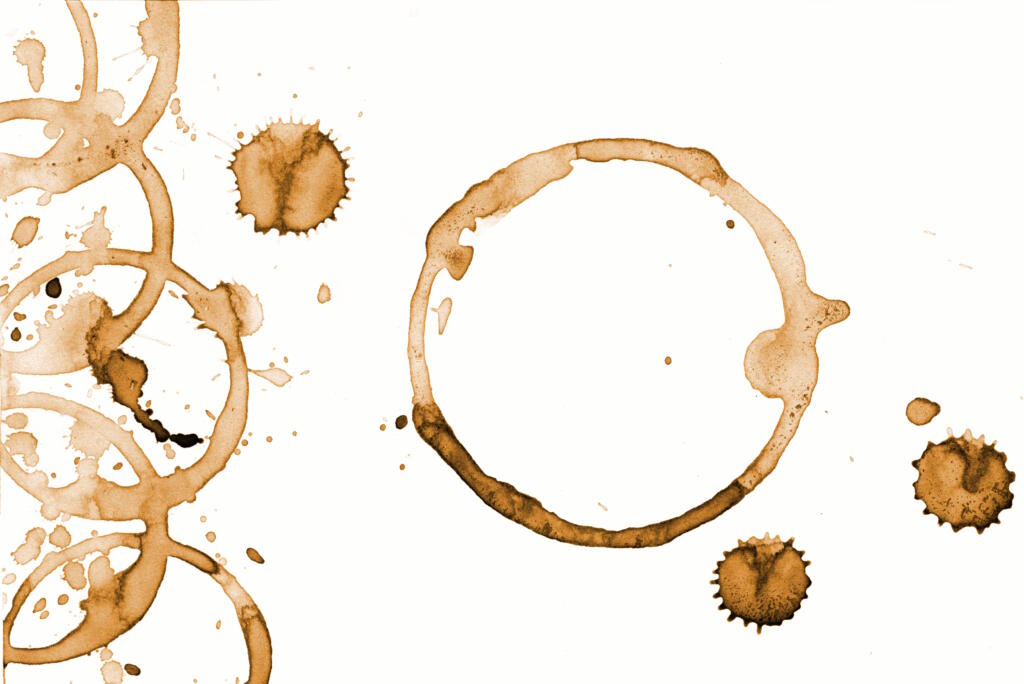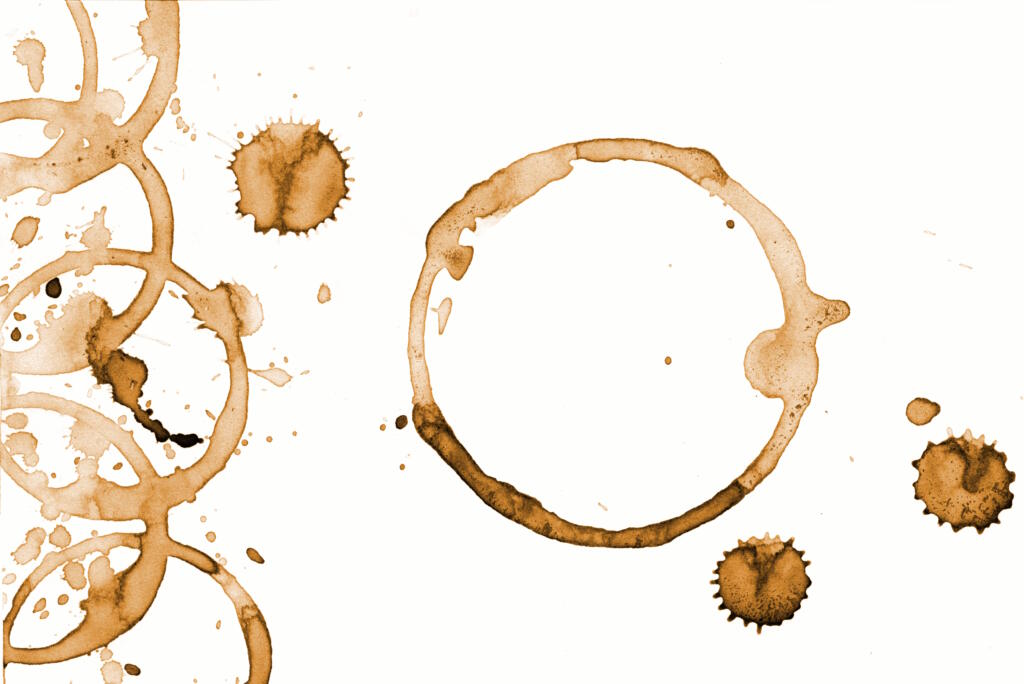Do you want to learn an artistic technique to make your coffee creations look like something from a professional cafe? Then the coffee ring effect is just the thing for you!
Table Of Contents
−- What is the Coffee Ring Effect?
- History of the Coffee Ring Effect
- How Does the Coffee Ring Effect Occur?
- The Physics Behind the Coffee Ring Effect
- Applications of the Coffee Ring Effect
- Experimentation of the Coffee Ring Effect
- The Effect on Industrial Processes
- Coffee Rings in Art and Design
- Coffee Rings as a Teaching Tool
- Conclusion
This blog post will explore the coffee ring effect and how to use it to make amazing works of art with your morning cup of joe.

What is the Coffee Ring Effect?
The Coffee Ring Effect is a scientific phenomenon familiar to anyone who has watched a drop of coffee dry. It occurs when a drop of liquid dries on a solid surface, leaving behind a pattern of suspended particulate matter that forms a distinctive, darkened ring around the edge.
During drying, the outward drift of suspended coffee particles from the center causes this effect. This phenomenon has been studied since the 19th century, and its implications have been explored in industrial processes, art, and design and are used as a teaching tool in schools.

History of the Coffee Ring Effect
The coffee ring effect has been around since the mid-1800s, though it wasn’t until the 1930s that scientists could explain the phenomenon. The effect was first observed by German physicist Ernst Abbe, who noticed that if a droplet of colloid evaporated on a solid, the suspended particles would be left behind in a ring-like pattern.
Later, scientists were able to further explain the effect through contact line pinning and contact angle hysteresis. Today, the coffee ring effect is still studied and explored in various ways, from its applications in industrial processes to its use as an art form or teaching tool.
How Does the Coffee Ring Effect Occur?
The Coffee Ring Effect occurs when a droplet of colloid evaporates on a solid surface. This causes the droplet to be pinned at its contact line.
In contrast, occasional depinnings of the contact line may result in a flattening motion that pushes water, and anything suspended in it, such as coffee particles, to its edges. This outward drift of suspended coffee particles from the center causes a denser, darkened ring on the surface, giving rise to the phenomenon known as the Coffee Ring Effect.
By the time the drop fully evaporates, an uneven surface is left due to the ring-like shape that was created.
The Physics Behind the Coffee Ring Effect
The physics behind the coffee ring effect is quite fascinating. When a drop of liquid is spilled onto a surface and dries, the suspended particles are deposited in a ring-like pattern around the edges of the drop. This phenomenon is known as the coffee ring effect and has been studied extensively.
Research has identified two important factors that lead to this effect: the contact angle formed by the suspension of droplets on the surface and its solids content.
These factors help explain why particles are more concentrated at the edge of the dried droplet, resulting in a darker circle-like pattern. The coffee ring effect has interesting implications for industrial processes, such as inkjet printing and art and design. In addition, it can be used as an educational tool to help students understand basic concepts in physics, such as surface tension and capillary flow.
Applications of the Coffee Ring Effect
The coffee ring effect has a wide range of applications in industry, art, and education. Its influence on industrial processes can be seen in inkjet printing, as the deposits formed by the capillary flow can affect the resolution of patterns.
This phenomenon is also widely used in art to create interesting visuals and patterns. It can be used as a teaching tool to help students understand the physics behind it. In addition, research has been conducted on ways to counteract the coffee ring effect, allowing for more precise printing results. The coffee ring effect is an important phenomenon with various practical applications.
Experimentation of the Coffee Ring Effect
Experimentation of the Coffee Ring Effect has been conducted in various ways, from laser-induced differential evaporation to capillary flow and evaporation rates. The University of Pennsylvania physics team has successfully disrupted the ‘coffee ring effect’ by transitioning particle deposition patterns from coffee-ring patterns to central-peak patterns.
This method is based on a particle-size selection mechanism near the contact line and has allowed for further study of the physics behind this phenomenon. Through experimental methods, scientists have gained an even greater understanding of the coffee ring effect and how it could be applied in industrial processes, art, and education.
The Effect on Industrial Processes
The Coffee Ring Effect is of great significance in industry, as it can significantly compromise the performance of a manufacturing process involving evaporation. The non-homogenous deposition pattern created by the Coffee Ring Effect can impair the quality of the product and require a longer time for production due to additional steps taken to correct it.
As a result, understanding and controlling the CRE is essential for industrial applications. Various experiments have been conducted to study the phenomenon further, and new techniques, such as particle manipulation, have been developed to mitigate its effects. The knowledge about the Coffee Ring Effect has allowed manufacturers to develop more efficient and cost-effective processes.

Coffee Rings in Art and Design
Coffee rings can also be used in art and design, offering a unique and visually interesting aesthetic. By manipulating the rings’ shape, size, and contour, artists can create a wide range of patterns, designs, and textures. For example, by changing the size of the casting area, artists can create more pronounced or subtle shapes.
Additionally, by increasing the sharpness of the contours, they can create more complex designs. They can achieve unique color combinations and textures by experimenting with different concentrations of coffee and other materials. Coffee rings have been used in everything from wall art to jewelry, creating stunning works that combine science with art.
Coffee Rings as a Teaching Tool
Coffee rings can be used as an effective teaching tool due to their unique properties. Learning about the coffee ring effect can help students understand the underlying physics of particle separation and evaporation.
By experimenting with coffee rings, students can gain a better understanding of the principles behind the effect, as well as its potential applications in industrial processes. Additionally, exploring the creative potential of coffee rings could give students a newfound appreciation for the power of art and design.
Coffee ring experiments are also a great way to introduce young students to science and engineering concepts in a fun, engaging way.
Conclusion
The Coffee Ring Effect is an incredible phenomenon that has fascinated scientists and engineers for centuries. Its wide range of applications makes it a powerful tool for studying industrial processes. Its unique shape can also be a source of creative inspiration in art and design.
The Coffee Ring Effect is also an excellent teaching tool, as it can help students understand complex scientific concepts in an accessible way. The Coffee Ring Effect is an invaluable phenomenon that will continue to fascinate us for years.
Sources:
- https://en.wikipedia.org/wiki/Coffee_ring_effect
- https://www.nature.com/articles/nature10344
- https://pubs.acs.org/doi/10.1021/acs.jpcc.9b00797
- https://www.rsc.org/news-events/journals-highlights/2018/sep/coffee-ring-effect/
- https://pubs.acs.org/doi/10.1021/ac102963x
- https://www.unr.edu/nevada-today/news/2016/new-coffee-ring-effect-model
- https://www.nature.com/articles/srep24628
- https://mappingignorance.org/2013/06/07/the-coffee-ring-effect/
- https://www.iasgyan.in/daily-current-affairs/coffee-ring-effect
- https://www.nature.com/articles/s41598-017-00497-x
- https://phys.org/news/2021-11-principle-coffee-effect-quantum-dot.html
- https://scitechdaily.com/physics-mystery-behind-coffee-ring-formation-uncovered/
- https://www.sciencedirect.com/science/article/abs/pii/S0165993622002357
- https://manu56.magtech.com.cn/progchem/EN/10.7536/PC150230
- https://www.researchgate.net/figure/The-suppressed-coffee-ring-effect-with-increasing-evaporation-rate-a-b-Images-and_fig1_301535817
- https://www.nature.com/articles/s41598-018-20581-0
- https://www.sci.news/physics/physicists-to-disrupt-the-coffee-ring-effect.html
- https://www.researchgate.net/publication/322205116_A_Review_on_Suppression_and_Utilization_of_the_Coffee-Ring_Effect
- https://www.sciencedirect.com/science/article/am/pii/S0021979720303957
- https://pubs.rsc.org/en/content/articlehtml/2018/sc/c8sc03302a
- https://link.springer.com/article/10.1007/s10570-018-2167-7
- https://www.futurelearn.com/info/courses/everyday-chemistry/0/steps/22339
- https://www.mrsec.psu.edu/highlights/2017-highlights/controlling-coffee-ring-effect-design-coatings-cosmetics-and-spray-drying
- https://www.researchgate.net/publication/329767868_Asymmetrical_coffee_rings_from_cellulose_nanocrystals_and_prospects_in_art_and_design
- https://onlinelibrary.wiley.com/doi/abs/10.1002/anie.201406903
- https://www.caffesociety.co.uk/blog/the-science-of-the-coffee-ring-effect
- https://research.tudelft.nl/files/93598505/1_s2.0_S0001868617303664_main.pdf
Disclaimer: This post contains affiliate links, which means I may receive a small commission, at no extra cost to you, if you make a purchase using these links. Remember to support us by purchasing through the Amazon/Walmart/Impact Radius links provided. Last update on 2024-04-25 / Affiliate links / Images from Amazon Product Advertising API
Disclosure: No compensation or free products were received in exchange for writing this review.

Editorial Staff
The editorial staff at Crazy Coffee Crave is a team of coffee enthusiasts & Baristas who enjoy the one thing we all think about as soon as we get up in the morning. Trusted by thousands of readers worldwide.





